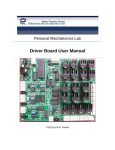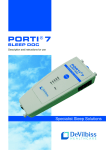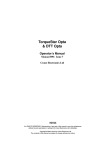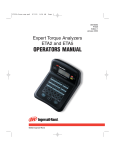Download Utility Board User Manual
Transcript
Personal Mechatronics Lab Utility Board User Manual ©2012 by M.R. Emami Utility Board User Manual 1 Table of Contents 1 Table of Contents .................................................................................................................................. 1 2 Introduction .......................................................................................................................................... 3 3 4 5 2.1 Overview ....................................................................................................................................... 3 2.2 Modules ........................................................................................................................................ 4 2.2.1 Power Module....................................................................................................................... 4 2.2.2 Transistor Tester ................................................................................................................... 4 2.2.3 IR Emitter Tester ................................................................................................................... 4 2.2.4 Continuity Tester................................................................................................................... 4 2.2.5 Function Generator ............................................................................................................... 4 2.2.6 Battery Charger ..................................................................................................................... 5 2.2.7 Oscilloscope .......................................................................................................................... 5 Power Module....................................................................................................................................... 6 3.1 Instructions ................................................................................................................................... 6 3.2 Schematic ...................................................................................................................................... 7 3.3 Power Control ............................................................................................................................... 7 3.4 Voltage Converter ......................................................................................................................... 7 3.5 Filtering ......................................................................................................................................... 8 3.6 ON/OFF Switch .............................................................................................................................. 8 Transistor Tester ................................................................................................................................... 9 4.1 Instructions ................................................................................................................................... 9 4.2 Schematic .................................................................................................................................... 10 4.3 Determining Functionality .......................................................................................................... 10 4.4 Pin Arrangement ......................................................................................................................... 11 4.5 Method of Testing....................................................................................................................... 11 4.6 Female Header Arrangement ..................................................................................................... 11 IR Emitter Tester ................................................................................................................................. 12 5.1 Instructions ................................................................................................................................. 12 5.2 Schematic .................................................................................................................................... 12 5.3 Determining Functionality .......................................................................................................... 13 Personal Mechatronics Lab 1 Utility Board User Manual 6 7 8 9 Continuity Tester................................................................................................................................. 14 6.1 Instructions ................................................................................................................................. 14 6.2 Schematic .................................................................................................................................... 15 6.3 Sound .......................................................................................................................................... 15 6.4 Connection Notes ....................................................................................................................... 15 6.5 Connection Types........................................................................................................................ 15 Function Generator ............................................................................................................................. 16 7.1 Instructions ................................................................................................................................. 16 7.2 Schematic .................................................................................................................................... 17 7.3 Output Waveforms ..................................................................................................................... 18 7.4 Frequency Adjustment ................................................................................................................ 18 7.5 Potentiometers (trimmers) ......................................................................................................... 18 Battery Charger ................................................................................................................................... 19 8.1 Instructions ................................................................................................................................. 19 8.2 Schematic .................................................................................................................................... 21 8.3 Number of Cells........................................................................................................................... 21 8.4 Power .......................................................................................................................................... 21 8.5 Trickle/Fast Charge ..................................................................................................................... 22 8.6 Heat issues .................................................................................................................................. 22 8.7 General Information on NiMH Batteries..................................................................................... 23 Oscilloscope ........................................................................................................................................ 24 9.1 Instructions ................................................................................................................................. 24 9.2 Schematic .................................................................................................................................... 25 9.3 Installation .................................................................................................................................. 26 9.4 PIC Firmware ............................................................................................................................... 26 9.5 Programming the PIC .................................................................................................................. 27 9.6 PC Driver ..................................................................................................................................... 27 9.7 PC Application ............................................................................................................................. 27 9.8 Data Acquisition .......................................................................................................................... 30 9.9 PIC Driver Mode .......................................................................................................................... 31 Personal Mechatronics Lab 2 Utility Board User Manual 2 2.1 Introduction Overview Utility Board is a testing, charging, monitoring and signal generator board developed to aid post-secondary students and designers with electronic design projects. It is powered entirely using USB power with a built in DC-DC converter. It contains six distinct modules, some of which are connected to each other - a transistor tester, IR emitter tester, continuity tester, a signal generator (square, triangle and sine) capable of producing signals up to 100KHz, an oscilloscope capable of simultaneous monitoring of dual channel analog signals up to 30 KHz, and a battery charger that can charge up to 8 NiCd or NiMH cells at a time. Figure 1: Overview of the Utility Board and its modules Personal Mechatronics Lab 3 Utility Board User Manual 2.2 Modules Below is a brief description of the features and purpose of each of the modules. 2.2.1 Power Module The power module supplies power for all modules including the battery charger. Upon connecting the board to a USB port (PC or a wall outlet), the battery module is powered with +12V. This allows the other modules to be turned off while charging overnight or for extended periods of time. Upon switching on the board, the board is simultaneously supplied with 5V, +12V and -12V to power all other modules. The +12V and -12V is attained from the USB port using a DC-DC converter. This makes it very simple to power the board. 2.2.2 Transistor Tester The transistor tester checks the functionality of NPN or PNP transistors of any pin configuration. It determines in which of three states the transistor is in – (A) functional; (B) base-collector short or collector-emitter short; or (C) base-emitter short. This tester is able to test out larger transistor packages on board. 2.2.3 IR Emitter Tester This module allows the user to connect an infrared emitter and determine its functionality through an indicator LED. Alternatively, the user may position the Utility Board near an IR emitter in an external circuit. But in either case, the detector on the Utility Board must be within 10 mm of the emitter. 2.2.4 Continuity Tester The continuity tester tests the connection between traces, wires, and solders points. The tester is rated at 30Ω. Therefore, it detects resistance less than 30Ω as being a short circuit. When two points are electrically connected, the buzzer beeps, indicating a connection. The buzzer is a piezo electric device that produces high decibels using low current usage. 2.2.5 Function Generator The function generator module on the Utility Board uses the XR2206 controller to produce square, triangular, or sinusoidal waves of up to 100kHz or as low as 1Hz, with a tested range of -10V to +10V. Using jumpers and trimmers, one can adjust offset, frequency, duty cycle, and amplitude. One common use for a function generator is to produce a clock signal for the Driver Board, for example. Personal Mechatronics Lab 4 Utility Board User Manual 2.2.6 Battery Charger This module allows the user to charge between 1 and 8 NiMH rechargeable battery cells, with a typical charge time of 3 hours. It has fast charge and a trickle charge mode that is autonomously controlled to allow for efficient charging. 2.2.7 Oscilloscope This module’s primary function is a dual channel PC oscilloscope with a maximum sampling rate of 30kHz. It contains a PIC18F2550 microcontroller, which runs as an HID USB device and interfaces to a Windows PC. Its secondary function is to act as a regular PIC driver. 18 input/output pins are included in the module to allow the user to run custom code on the PIC, with the option of communicating with a PC through the USB interface for advanced users. The mounted oscillator clock frequency is 20 MHz. Furthermore, the PIC can be programmed using bootloader by pressing the boot switch down while powering the board. Personal Mechatronics Lab 5 Utility Board User Manual 3 Power Module The power module provides power for all of the other modules except for the battery charger. 3.1 Instructions A. Connect the board to a USB port to enable the battery module (+12V). B. Turn on the switch to enable -12V, and +5V. Figure 2: Physical location of the Power module Personal Mechatronics Lab 6 Utility Board User Manual 3.2 Schematic Figure 3: Schematic of the Temperature Sensor module 3.3 Power Control The utility board does not require any power terminals. The switch, along with the USB port, is capable of providing power to the different modules. Action USB Connected (Switch OFF) USB Connected (Switch ON) Transistor Tester IR emitter Powered modules Continuity Function Tester Generator Oscilloscope Charger Table 1: Power requirement for different modules 3.4 Voltage Converter The utility board uses a built-in voltage booster to convert +5V to +12V and -12V. The converter is a dual output converter (RB-0512D) manufactured by Recom International. The converter accepts +5V and supplies a dual output power line of ±12V. The converter is, however, nonisolated and hence, the input and the output are electrically linked. Thereby if noise is present on the output, it will also be produced on the input line. Furthermore, the converter provides an output current of ±42mA on the supply lines respectively. Personal Mechatronics Lab 7 Utility Board User Manual 3.5 Filtering The voltage converter is non-isolated and thus the output lines and the input lines are electrically linked. However, the input line (+5V) is being used by most of the modules. It was noted that 10MHz ripples of 150V p-p were being produced by the converter, which were measured on the input line. Since the input line was being utilized for the oscilloscope, the noise was too prevalent for the proper operation of the PIC microcontroller which uses a 20MHz oscillator. Hence, a ferrite bead, along with a 470µF capacitor, was used in-between the converter’s input and the node where the modules were attaining the +5V power. This reduced the noise to 20mV p-p, which is clean enough for proper operation. 3.6 ON/OFF Switch An ON/OFF switch was necessary to keep the modules powered off although the USB (power source) might be connected. With the addition of the PIC I/O bus, the switch and LED were deemed necessary for convenience for regular use of the PIC. The switch provided power to all modules except the battery charger. The battery charger was powered upon connection to a USB port. The switch selected for this board was the MS22 from APEM Components, the one used as the power switch for the DevBugger Board. The DPDT switch allowed simultaneous control of -12V and +5V. The +12V line was independent of the switch, as it is turned on upon connecting the USB port to allow the battery charger to function. This particular switch was chosen because of three reasons – first, it is durable and robust, which is a benefit for a switch which is used as often as the power switch; second, it is cheap and readily available; and third, it has proven to be a reliable choice for a power switch on the DevBugger Board. The resistor used for the power indicator LED has a value of 1k. A similar LED circuit in the transistor tester uses a 330 ohm resistor, but a higher resistor was selected at the cost of LED brightness because the power LED is on more often than other LEDs. Personal Mechatronics Lab 8 Utility Board User Manual 4 Transistor Tester The transistor tester module checks both NPN and PNP transistors for collector-emitter shorts and disconnections. The user must insert the transistor in the appropriate pin slots and observe the indicator LED with the switch off and then on. 4.1 Instructions A. Insert the transistor in the appropriate slots in the NPN or PNP female header. B. Observe the LED – LED1 for NPN and LED2 for PNP. C. Hold the switch and observe the LED again – SW1 for NPN, SW2 for PNP. Figure 4: Physical Location of the Transistor Tester module Personal Mechatronics Lab 9 Utility Board User Manual 4.2 Schematic Figure 5: Schematic of the Transistor Tester module 4.3 Determining Functionality With the switch off, the circuit tests CE short cases. A working transistor leaves the LED off, and a transistor with a CE short turns the LED on. With the switch pressed, the circuit becomes a CE open tester. A working transistor turns the LED on, and one with the collector and emitter permanently open turns the LED off. Thus, a transistor is working only if the LED is off with the switch off and the LED is on with the switch pressed. LED when switch not pressed LED off LED off LED on LED on LED when switch pressed Transistor Status LED off LED on LED off LED on BE short Working N/A BC short or CE short Table 2: Guide for testing the functionality of transistors Personal Mechatronics Lab 10 Utility Board User Manual 4.4 Pin Arrangement For NPN transistors, use the NPN header, LED1, and SW1; for PNP transistors, use the PNP header, LED2, and SW2. For correct results, it is necessary to insert the transistor in the right slots, depending on if the transistor is BCE, CBE, or CEB. An additional pin was added to support large package transistor and large package power Darlington transistors such as the TIP142, which is popular in motor-related operations. 4.5 Method of Testing A transistor has two states depending on whether current is flowing into the base or not. Thus, it is not possible to fully test the functionality of a transistor without checking both cases. In the previous design, SW1 and SW2 were LEDs, so only the case where current is flowing into the base was tested. With the addition of the switches, it is possible to simulate both inputs into the base. With the switch not pressed, the transistor should not allow current to pass between the collector and the emitter, so the LED should be off unless there is a CE short or a BC short (since the base is pulled up). When the switch is pressed, current is flowing into the base, so the collector-emitter junction should behave like one continuous connection, so the LED should turn on, unless the base-emitter junction is likely shorted. To test all potential cases where the transistor is not behaving normally, the tester must check it in both the transistor ‘on’ and ‘off’ cases. The first alternative solution involves the use of a timer IC to check both cases was considered, but the minor convenience gained was deemed to be insignificant compared to the simplicity and economy of the chosen design. The second solution involves the use of a bicolour LED to indicate if the transistor is working or not. It is a common misconception amongst students that the transistor is working when the LED lights green even when the switch is not pressed. For this reason, it was believed that using a bicolour LED and making it turn red when the switch is not pressed, whenever there is a BC or a CE short, would make it clearer. However, this required a DPDT momentary switch which was hard to find. 4.6 Female Header Arrangement Currently, the header has an EBCEBC arrangement to account for all combinations of base, collector, and emitter. Using the present arrangement allowed for large transistors. Furthermore, the current socket not only provides mechanical stress to tightly hold on to the legs, but also is able to accept large sized legs. Personal Mechatronics Lab 11 Utility Board User Manual 5 IR Emitter Tester This module allows the user to check the functionality of an infrared emitter. The emitter must be inserted with the longer pin (positive lead) on the outside. 5.1 Instructions A. Insert the IR emitter in the female header with the longer lead on the outside. B. Observe the LED indicator. Figure 6: Physical Location of the IR Tester module 5.2 Schematic Personal Mechatronics Lab 12 Utility Board User Manual Figure 7: Schematic of the Transistor Tester module 5.3 Determining Functionality The LED indicates functionality of the IR emitter. LED Status Not Working Working Table 3: Guide for testing the functionality of IR emitters The leads of the emitter must be bent to position and orient it such that the detector receives the radiation with a large enough intensity. During tests, the module functioned correctly when the separation was less than 10 mm, but the angle of the emitter was not significant as long as it was generally in the direction of the detector. The brightness of the LED is continuous to show how much infrared waves are being picked up by the detector. It is not always either fully on or fully off. Personal Mechatronics Lab 13 Utility Board User Manual 6 Continuity Tester The continuity tester indicates if there is a connection present between two points. Upon detecting a resistance less than 30Ω, the piezo buzzer produces a sound to indicate that a connection is, in fact, present. 6.1 Instructions A. Strip two jumper wires on both sides B. Insert one side of each jumper wire into the two input terminal C. Use the other end to check for connection Figure 8: Physical Location of the Continuity Tester module Personal Mechatronics Lab 14 Utility Board User Manual 6.2 Schematic Figure 9: Schematic of the Continuity Tester module 6.3 Sound The continuity tester uses a piezo buzzer. This buzzer is rated at 80 dB at a distance of 10cm, which is loud enough to hear the sound even in a noisy environment. However, the sound block filter can be left on the buzzer to reduce the volume if necessary. The buzzer is also a low power device that uses only 7mA to operate. This makes it an effective buzzer choice 6.4 Connection Notes The continuity tester is rated to detect a resistance of less than 30Ω. This means that a resistor with resistance less than 30Ω will be detected as a short circuit. If a discontinuous or very faint sound is produced, then the connection might be very weak and must not be relied upon. 6.5 Connection Types The continuity tester can test any circuits that a conventional continuity tester in a multimeter is able to test. It is ideal for PCB traces and wires, but can also be used to test if a cold solder is present or not. A multimeter probe may be attached to the terminals as well. Personal Mechatronics Lab 15 Utility Board User Manual 7 Function Generator The function generator outputs sinusoidal, triangular, or square waves, with adjustable parameters. 7.1 Instructions A. Connect a wire to the SQR or SINE TRIG terminal B. For the latter, specify SINE or TRIG, using the slide switch located next to the terminal. C. Select a TIME BASE jumper. Figure 10: Physical Location of the Function Generator module Personal Mechatronics Lab 16 Utility Board User Manual 7.2 Figure 11: Schematic of the Transistor Tester module Personal Mechatronics Lab 17 Utility Board User Manual Schematic 7.3 Output Waveforms The function generator module can produce three types of signals, shown below. The SQR slot in the push terminal outputs a square wave which can be used as a clock for many applications, such as the Driver Board. The SINE TRIG slot in the push terminal outputs either a sinusoidal or triangular wave, depending on where the switch is set. Connected output channel SQR SINE/TRIG SINE/TRIG Switch N/A TRIG SINE Output waveform Square wave Triangular wave Sinusoidal wave Table 3: Types of output waveform, with required switch configurations 7.4 Frequency Adjustment The frequency of the output waveform is adjusted using two methods. First, the timescale jumper pins select a coarse frequency range for the waveform, described below. The fine adjustment of the frequency is done using the frequency trimmer. Timescale jumper 500 ms 50 ms 5 ms 0.5 ms 0.05 ms Minimum frequency 1 Hz 10 Hz 100 Hz 1000 Hz 10000 Hz Maximum frequency 10 Hz 100 Hz 1000 Hz 10000 Hz 100000 Hz Table 4: Frequency range for each timescale jumper selection 7.5 Potentiometers (trimmers) The trimmers adjust the five waveform parameters listed below. They are 20 turn potentiometers whose ranges are described in the table below. Parameter Voltage Offset Frequency Duty cycle Amplitude Description Adjusts the top voltage of the square wave Translates the DC component up or down Fine adjustment of frequency Changes the shape of the waveform Changes the voltage range of the waveform Range 0V to 10V -10V to 10V Min. to max. freq. (see above) N/A 0V to 10V Table 5: Range of each potentiometer along with their description Personal Mechatronics Lab 18 Utility Board User Manual NOTE: The “Offset” trimmer is for the sinusoidal or triangular waves only. 8 Battery Charger The battery charger module allows the user to charge between 1 and 8 NiMH or NiCd rechargeable battery cells. The module is powered internally using the DC-DC converter, and is provided with +12V. This means up to 8 cells can be charged. 8.1 Instructions A. Connect the BAT and BAT_POW terminals to the battery and power supply, respectively. B. Connect the appropriate PGM0 and PGM1 jumpers according to the number of cells. Personal Mechatronics Lab 19 Utility Board User Manual Figure 12: Physical Location of the Battery Charger module Personal Mechatronics Lab 20 Utility Board User Manual 8.2 Schematic Figure 13: Schematic of the Battery Charger module 8.3 Number of Cells PGM1 The user must select the correct jumpers to specify the number of cells being charged. Failing to select the correct jumpers will cause the charge termination circuitry to fail, which may cause permanent damage to the battery by overcharging it. With the current design, a matrix chart was printed on the board itself that allowed the user to select the jumpers to select an element in the matrix, which is the number of cells. With the addition of a jumper slot (REF, it was made possible to charge 3, 5, and 7 cells. The matrix printed on the board looks like what is shown on the following table. Selecting V+ and V+ for example sets the board to charge 1 cell while selecting O and O allows the board to charge 6 cells etc. PGM0 V+ O V+ 1 5 O 2 6 REF 3 7 BATT- 4 8 Table 6: Battery number selection matrix Personal Mechatronics Lab 21 Utility Board User Manual 8.4 Power The battery module is powered by the built-in voltage converter that provides +12V. Upon connecting the board to a USB port, the RED LED (CHARGE) turns on to indicate that the battery charger module is powered. The resistor used for this LED is 2.4K as it is being supplied by +12V. Hence, a larger resistor was required to limit the current. It is important to note that the battery charger module is always powered once the USB is connected. This was a design decision made to reduce the number of power switches. It was possible to add a second power switch to control power to the battery charger. However, this was deemed unnecessary since the action of switching the USB is analogous to a switch. Once the USB is connected, it is as if the battery charger is enabled. The other switch controls power to other modules to prevent them from turning on when the battery module is charging (which may be for extended periods of time). Furthermore, the IC used in this module has an auto shutdown mode that disables the IC from drawing too much current when no batteries are connected to the terminals. This is done by using a temperature sensor which detects the temperature of the battery. When no battery is connected, the temperature is negligible and so no power is drained by the module. For this reason, it is possible to keep the battery charger turned on, even though no batteries are being charged. 8.5 Trickle/Fast Charge The MAX713 chip, which controls the charger module, is always in one of two states – trickle charge or fast-charge. In trickle charge mode, a small current is supplied to the battery to charge it very slowly and possibly, indefinitely. In fast-charge mode, a high current is forced into the rechargeable battery. The MAX713 enters and remains in fast-charge under specific conditions. The fast-charge mode begins when the charger is powered or a battery is inserted and two conditions are satisfied: the voltage per cell is above 0.4 V and the temperature is above a minimum required level. The battery is in fastcharge mode for the bulk of the charge time and then fast-charge is terminated by any of three events: a negative battery voltage slope, a cell temperature above a maximum pre-set level, or the charge time being expired. The fast-charge mode is indicated by an LED. 8.6 Heat issues Both the MAX713 chip and the voltage regulator have tendencies to heat up to a high level. During fast-charge, both heat up and cool periodically, but remain at a high temperature. The voltage regulator gets hot enough that touching the heat-sink for five seconds gets very uncomfortable, but for both the voltage regulator and the chip, the temperatures have not exceeded operating levels. Personal Mechatronics Lab 22 Utility Board User Manual Even when batteries are not being charged, the IC tends to get hot when the jumpers are placed on O (Open), and BATT- slots. For this reason always place the jumpers on other settings such as V+ and V+. This prevents the IC from getting hot unnecessarily. 8.7 General Information on NiMH Batteries Figure 14: characteristics at c/2 rate Figure 15: characteristics at fully charged state Among rechargeable batteries, NiMH is known for having high capacities and good performance, while being less polluting than NiCd rechargeable batteries. A typical AA NiMH battery has a capacity of 2000 mAh – it takes one hour to fully discharge a fully charged battery or vice versa at 2000 mA. However, rechargeable batteries should not be fully discharged. For most of a cycle, a battery delivers the nominal 1.3V, but it should not be allowed to drop below 0.7V to 0.9V, depending on the battery. A full charge of a battery should have a voltage-time curve that is similar to the image onf the right above. Immediately after fast-charge begins, the voltage should jump to 1.3V-1.4V. After this short period, the slope levels off and stabilize to a steady rate for much of the charge. When the battery is fully charged, it gets hot and the voltage should start decreasing – either of these conditions will trigger the fast-charge termination mechanism, at which point the current is reduced to a safe level in trickle charge mode. Personal Mechatronics Lab 23 Utility Board User Manual 9 Oscilloscope The oscilloscope module takes in voltage input, carries out the analog-to-digital conversion, and sends the data to a PC over a USB cable. Its maximum sampling frequency is 200kHz. 9.1 Instructions A. Select PIC or OSC on the slide switch for PIC driver mode or oscilloscope mode. B. Connect AUTO or MAN on the VREF jumper to select automatic or manual voltage reference. C. Connect the signal to Ch A or Ch B in the analog input terminal. Figure 16: Physical Location of the Oscilloscope module Personal Mechatronics Lab 24 Utility Board User Manual 9.2 Figure 17: Schematic of the Oscilloscope module Personal Mechatronics Lab 25 Utility Board User Manual Schematic 9.3 Installation Installation for the oscilloscope is very simple and consists of the following easy steps: 1. Install the oscilloscope application. 2. Ensure that the slide switch is set to OSC, not PIC. 3. Connect the Utility Board to the PC using the USB cable. 4. Apply power to the board and turn the power switch on. 5. The computer should automatically detect the board and install drivers within seconds. 6. Start the application. 7. Above the screen, the yellow light should turn on and it should display “Connected.” 8. Click on the play button to begin acquisition. 9. Select a time-base (TIME/DIV) appropriate for the expected frequencies of the signals. The oscilloscope module can be broken down into three components: the PIC firmware, PC driver, and PC application. 9.4 PIC Firmware The oscilloscope module uses a PIC18F2550 to control the data acquisition and USB communication with the PC. The code is a modified version of Microchip’s HID device firmware written in C, with custom code written for the oscilloscope data acquisition and transfer. The user has the option of using this chip as a secondary micro-controller as there is a slide switch that allows the user to run any custom user code written in the program memory of the PIC. In order to reprogram the PIC to take advantage of this option, the user must use a programmer such as the one on the DevBugger to program the PIC18 with the user code appended to the USB oscilloscope code. Address Program memory Switch 0000 BTFSS PORTA, 0 Bootloader 5V BRA PIC //jumps to PIC RA0 BRA OSC //jumps to OSC GND OSC 1000 Oscilloscope code PIC 8000 Custom user code PIC18 Personal Mechatronics Lab 26 Utility Board User Manual 9.5 Figure 18: General overview of the firmware Programming the PIC The current version was implemented with a bootloader switch to enable onboard programming. By pressing the switch down while powering on the board, the PIC enters the bootloader which can be detected by the PC to enable programming. From this point, using PICFUSB software, the PIC can be programmed with any hex code. This allows the user to program user code very easily, making the utility board a simple programming board as well. In order to program the PIC with user code, use “PDFUSB” software. Press the bootloader switch with the software on to enter the bootloader. Once in the bootloader, select the hex file that you want written to the pic. The hex file must include the firmware for the oscilloscope and the user code appended to it. Follow the instructions below to create a programmable hex. 1. With User Code a) Combine files 1-4 in the order to make a hex file with user code that causes B3 to blink. b) The bootloader hex has already been edited to correct for end of file etc. c) In order to use a different user code, simply set the .org to 0x2C00 and export starting at 0x2C00 also. d) Remember there are 21502 instructions available for programming. e) After this, the new user code can be combined in place of the included blinker code (the blinker code is included as an example). 2. Without User Code a) Combine files 1, 2, and 4 to create a programmable hex file without any user code. b) Address starting from 0x2C00 will be empty *0-FINAL is a hex file without user code and 0-FINAL (with user) is an example hex file with an example user code that blinks the B3 pin. Install “Utility Board” to access these hex files. 9.6 PC Driver The PIC firmware was written to communicate with the PC as an HID device. When the oscilloscope is connected, the PC recognizes it as a Human Interface Device, which is a standard device class recognized in most Windows platforms. The advantage of selecting the HID device class is that there is no need for the user to acquire and install any custom drivers on the PC – HID drivers should be included in any Windows-based PC, and detection and installation of the device should be automatic and take mere seconds to complete. 9.7 PC Application The graphical user interface of the oscilloscope is presented below. The layout is very simple: at the centre of the application is the signal display region surrounded by 11 time-base options – Personal Mechatronics Lab 27 Utility Board User Manual equivalent to time per division. The top row’s 7 time-bases are for relatively low-frequency signals, so they use real-time streaming mode. The bottom 4 time-bases works for highfrequency signals, so they use block acquisition mode. To the right and left of the main, centre column, the four channels are presented as quadrants. Typical oscilloscope parameters such as VOLT/DIV and offset are controlled for each channel individually, independent from the other channels. Figure 19: The main window of the PC software application Control options. The three buttons for acquisition control – stop, start, and pause – are located below the main display region: o The stop button halts acquisition if it has started, clears the screen, and resets the internal application clock used for time-stamping when saving data to a text file. o The start button begins or resumes acquisition depending on whether acquisition was previously paused. In the latter case, the application resumes drawing from where it left off if in streaming mode and the clock does not start from 0. o Finally, the pause button halts acquisition, but does not clear the screen, nor does it reset the clock. The start and pause buttons are enabled and disabled where appropriate, based on the state of the application. Saving. One of the features of the oscilloscope is the ability to save data to a text file as it is acquired. In order to do this, the user must click save, opening a dialog in order to specify an output location. The oscilloscope then enters recording mode, during which it records whatever data is being displayed on the screen simultaneously to a text file with a timestamp. To exit Personal Mechatronics Lab 28 Utility Board User Manual recording mode, the user must click what was previously the save button. In recording mode, stopping or pausing acquisition does not make it exit recording mode. Channel parameters. Conveniently, each of the 4 quadrants represents a group of parameters for a common channel. Within each channel group, there are 4 subdivisions – display select, readings display, voltage per division, and calibration. Furthermore, each of the channels can be enabled or disabled independently by clicking on the Channel label button: o Display select allows the user to choose from 3 options. Selecting DC displays the unchanged signal obtained for the particular channel, while the AC option filters out the DC component (the signal average) to output the pure AC signal. Selecting GND displays the equivalent of a constant, 0 V signal – this allows the user to quickly see visually what offset the oscilloscope is using. o The readings group shows real-time voltage and average voltage. Real-time voltage is displayed much quicker than the average voltage since the average is not as responsive to sudden changes, so it does not change quickly anyway. The array size for calculating average is 2000 for streaming mode and 800 for block mode. o The voltage per division group allows the user to select from 6 pre-selected common voltages per division. Alternatively, the user can type a custom voltage per division for more precision. o The calibration group allows for adjustment of offset and amplitude for the channel. To emphasize that these should be adjustment for calibration purposes, they are disabled by default and must be enabled by clicking set. File menu. There are three main drop-down menus, View, Reset, and Calibrate: o The view menu provides a secondary way to enable and disable channels, as well as the additional options of enabling or disabling all at once. o The reset menu resets channels to default, individually or all at once. o The calibrate menu provides an automatic method to calibrate offsets. Taring one or all of the channels takes whatever voltage is being read for each channel and sets that value as the new zero. Additionally, the user can also reset all offsets to default (no offset). Personal Mechatronics Lab 29 Utility Board User Manual Figure 20: The three main drop-down menus 9.8 Data Acquisition There are two modes of operation under which the oscilloscope acquires data: The first is streaming mode. This mode acquires a sample roughly every millisecond and the plot is a continuous display of points, although they are spaced relatively far apart in time. This mode is slow because the PIC acquires a sample, then waits while the data is transmitted over the USB bus to the PC. Thus, for every sample, the cycle of acquisition and transmission repeats indefinitely. Figure 21: Data acquisition in streaming mode The second is mode of operation is the block acquisition mode. This mode was developed to allow users to see high frequency signals through higher resolution acquisition. Since the USB transfer time is significant, the PIC does not wait after each sample is acquired for the data to transfer to the PC; it fills up its memory banks with 196 consecutive samples, and then transfers them all at once after acquiring 196 samples. The resolution of the samples is only limited by the acquisition time – the time the AD converter takes to convert the analog signal into binary numbers added to the time the PIC takes to process the sample data and store it. The AD converter takes 4 µs and the PIC takes 2 µs for a total of 7 µs. The result is a maximum sampling rate of 166.6 kHz, significantly greater Personal Mechatronics Lab 30 Utility Board User Manual than that of the streaming mode, which is roughly 1 kHz. Using Nequist theorem, this puts the theoretical sampling frequency of the oscilloscope to half that, 83.33 KHz. With practical drawbacks, the final frequency that can be handled by the oscilloscope is 28 KHz. Frequencies above this can be handled but 100% accuracy is not guaranteed. The time-bases in the milliseconds range use streaming mode and those in the microseconds use block mode. Figure 22: Data acquisition in block acquisition mode 9.9 PIC Driver Mode The oscilloscope module uses a PIC18, so it can double as a secondary PIC driver. In order to use PIC driver mode, the user must set the slide switch from OSC to PIC with their code loaded onto the PIC. For this purpose, there are 17 I/O pins available to the user as male headers. PIC Driver Features: Microcontroller: PIC18F2550 I/O pins: 17 available Clock: 20 MHz Peripherals: USB; I2C possible In order to run custom user code on the oscilloscope’s PIC18F2550 with the oscilloscope still usable, the user must append their code to the end of the oscilloscope hex file. To do this, the user must do three things: 1. Modify the linker script for the user’s project so that the user’s code begins at line 2C00. 2. Take the user’s hex file, with its first line removed, and copy and paste it to the oscilloscope hex file, with its last line removed (using notepad). 3. In order to program the code there are two options Personal Mechatronics Lab 31 Utility Board User Manual a. Use the DevBugger to program this code onto the Utility Board’s PIC18, just as one would program the PIC16. b. Press the Bootloader switch while power on and open PDFSUSB software. Press the drop down menu and select the option. Load HEX file and press program device to program on the utility board directly using USB. If this is done successfully, the user can run both the custom code and the oscilloscope code using the same firmware, by using the PIC-OSC switch in the oscilloscope module. It is beneficial for the user to periodically check the RA0 pin – if it is high, the code should go to line 100, where the oscilloscope code lies. This enables the ability for the user to alternate between PIC and OSC modes using the switch, without turning off and turning on the power switch. An easier solution from a programming standpoint is to burn only the user code onto the oscilloscope’s PIC18 without appending it to the oscilloscope code. This is easier to do because the user only needs to write their code and burn it onto the PIC just as they would with the PIC16 without worrying about linker files or appending hexes. The disadvantage with this approach, however, is that the user would not be able to use the oscilloscope and the custom code using the same hex file. To switch back to the oscilloscope instead of the user’s custom code, one would have to burn the oscilloscope’s original firmware back onto the PIC. Personal Mechatronics Lab 32 Utility Board User Manual Utility Board QuickStart IR Emitter Tester Insert the emitter with the long pin on the outside, and bend the leads to bring it within 1 cm of the detector. Transistor Tester Insert the transistor in the correct NPN or PNP pin slots and observe the LED with the switch off and then on. Switch off Switch on Transistor LED off LED off BE short LED off LED on Working LED on LED on BC/CE short Continuity Tester Connect two wires to the terminals and use it to test connection between PCB traces, wires, and solder points. Function Generator Use either the TRIG or SQR output terminal. If the former is used, specify TRIG or SINE using the switch. Select a timescale jumper and use potentiometers to adjust the function. Minimum frequency 1 Hz 10 Hz 100 Hz 1000 Hz 10000 Hz Parameter Voltage Description Adjusts the top voltage of the square wave Translates the DC component up or down Fine adjustment of frequency Offset Frequency Duty cycle Amplitude Changes the shape of the waveform Changes the voltage range of the waveform Maximum frequency 10 Hz 100 Hz 1000 Hz 10000 Hz 100000 Hz Range 0V to 10V -10V to 10V Min. to max. freq. (see above) N/A 0V to 10V Battery Charger Connect the NiMH cell(s) and a power source with a voltage at least 1.5V greater than the total voltage of the battery and above 6V. Set the PGM0 and PGM1 according to the table below. PGM0 PGM1 Timescale jumper 500 ms 50 ms 5 ms 0.5 ms 0.05 ms Personal Mechatronics Lab V+ O REF BATT- V+ 1 2 3 4 O 5 6 7 8 Oscilloscope Set the VREF jumper to AUTO to use the capacitor or MAN to manually trim the MAN VREF potentiometer and control the reference voltage. Connect the channel input pins and the USB cable. Power Module Connect board to a USB port. Charging batteries do not require switch to be on. In order to operate other modules simply turn the switch on to enable -12V and +5V. 33















































